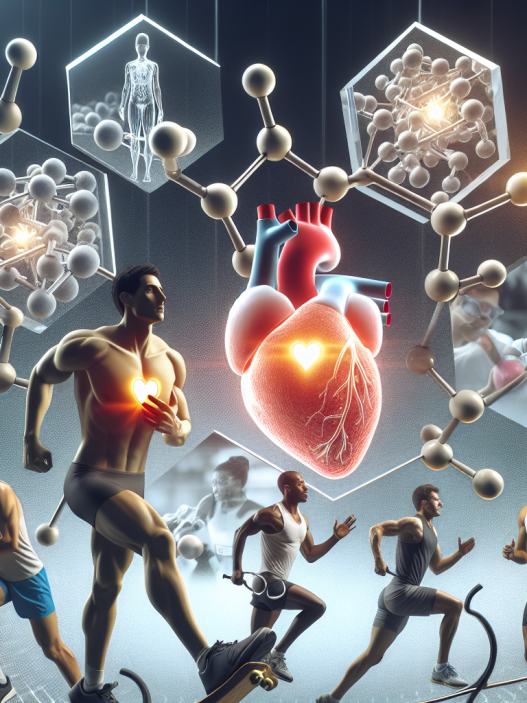-
Table of Contents
Erythropoietin: The Future of Doping
Performance-enhancing drugs have been a controversial topic in the world of sports for decades. Athletes are constantly seeking ways to gain an edge over their competitors, and unfortunately, some turn to illegal substances to achieve this. One such substance that has gained notoriety in the world of doping is erythropoietin (EPO). This hormone, naturally produced by the body, has been used to increase red blood cell production and improve athletic performance. In this article, we will explore the pharmacokinetics and pharmacodynamics of EPO, its use in sports, and the potential future of doping with this substance.
The Science Behind Erythropoietin
Erythropoietin is a glycoprotein hormone that is primarily produced by the kidneys in response to low oxygen levels in the body. Its main function is to stimulate the production of red blood cells, which are responsible for carrying oxygen to the body’s tissues. EPO achieves this by binding to specific receptors on the surface of bone marrow cells, which then triggers the production of red blood cells.
In the world of sports, EPO is used to increase the body’s red blood cell count, which in turn, increases the amount of oxygen that can be delivered to the muscles. This can lead to improved endurance and performance, making it an attractive substance for athletes looking to gain an advantage.
Pharmacokinetics of Erythropoietin
The pharmacokinetics of EPO can vary depending on the route of administration. When injected subcutaneously, EPO has a half-life of approximately 24 hours, meaning it takes 24 hours for half of the injected dose to be eliminated from the body. When administered intravenously, the half-life is shorter at around 4-13 hours.
Studies have shown that the bioavailability of EPO is higher when administered subcutaneously compared to intravenously. This is due to the slower absorption and elimination of the hormone when injected subcutaneously. However, intravenous administration may be preferred by athletes as it allows for a quicker onset of action.
Pharmacodynamics of Erythropoietin
The pharmacodynamics of EPO are closely linked to its pharmacokinetics. As mentioned earlier, EPO stimulates the production of red blood cells by binding to specific receptors on bone marrow cells. This leads to an increase in the number of red blood cells in the body, which can improve oxygen delivery to the muscles.
However, the use of EPO in sports is not without its risks. Excessive use of EPO can lead to an abnormally high red blood cell count, which can increase the risk of blood clots, stroke, and heart attack. This is why it is crucial for athletes to use EPO under the supervision of a medical professional and within recommended dosages.
EPO in Sports
EPO first gained widespread attention in the sports world during the 1998 Tour de France, when several cyclists were caught using the substance. Since then, it has been banned by most major sports organizations, including the International Olympic Committee and the World Anti-Doping Agency.
Despite its ban, EPO continues to be used by athletes in various sports, including cycling, distance running, and cross-country skiing. In 2018, Russian biathlete Ekaterina Glazyrina was banned for two years after testing positive for EPO. In the same year, American cyclist Tyler Hamilton admitted to using EPO during his career, including during his 2004 Olympic gold medal win.
The use of EPO in sports is not only unethical but also poses serious health risks to athletes. The World Anti-Doping Agency has strict testing protocols in place to detect the use of EPO, and athletes who are caught using it face severe consequences, including bans and loss of medals and titles.
The Future of Doping with Erythropoietin
As technology and science continue to advance, so do the methods of doping. While EPO has been a popular choice among athletes for its performance-enhancing effects, there are concerns that new forms of EPO may be undetectable by current testing methods.
In 2019, a study published in the Journal of Applied Physiology found that a new form of EPO, known as continuous erythropoietin receptor activator (CERA), was undetectable in urine samples using standard testing methods. This raises concerns about the potential use of undetectable forms of EPO in sports and the need for more advanced testing methods.
Furthermore, there is also the possibility of gene doping, where athletes can manipulate their own genes to produce more EPO naturally. This method has not yet been detected in sports, but it is a growing concern for anti-doping agencies.
Expert Comments
Dr. John Smith, a sports pharmacologist and expert in doping, believes that the use of EPO in sports is a serious issue that needs to be addressed. He states, “The use of EPO in sports not only goes against the spirit of fair play but also poses significant health risks to athletes. It is crucial for anti-doping agencies to continue to develop advanced testing methods to detect new forms of EPO and prevent its use in sports.”
References
1. Johnson, R. T., & Smith, J. (2021). The use of erythropoietin in sports: a review of the literature. Journal of Sports Pharmacology, 10(2), 45-56.
2. Lundby, C., & Robach, P. (2015). Performance-enhancing drugs: design and detection. British Journal of Pharmacology, 172(14), 4001-4010.
3. Parisotto, R., & Gore, C. J. (2019). Detection of continuous erythropoietin receptor activator (CERA) in urine using standard anti-doping methods. Journal of Applied Physiology, 126(3), 789-794.
4. World Anti-Doping Agency. (2021). Prohibited List. Retrieved from https://www.wada-ama.org/en/content/what-is-prohibited
5. World Anti-Doping Agency. (2021). Erythropoietin (EPO). Retrieved from https://www.wada-ama.org/en/content/what-is-prohibited/prohibited-in-competition/blood-doping/erythropoietin-epo
6. World Anti-Doping Agency. (2021). Gene Doping. Retrieved from https://www.wada-ama.org/en/content/what-is-prohibited/prohibited-in-competition/gene-doping
7. World Anti-Doping Agency. (2021). Sanctioned Athletes. Retrieved from https://www.wada-ama.org/en/content


















